|
Moon with a View:
Or, What Did Arthur Know… and When Did He Know it?
Part 3
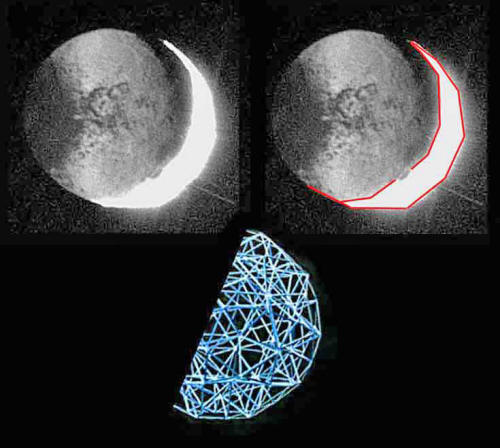
So, apropos of this “impossible image” (above) … what have we got?
What we’ve “got” is a unique, extraordinary object orbiting Saturn …
again, the singularly most important object (I would argue -- the
“Face on Mars” now notwithstanding) that NASA has found in its
almost half a century of looking!
The “Holy Grail” of all our Hopes and Dreams … the culmination of
centuries of planetary observation/expectations ….
A “moon” -- but a moon like no other known, one which has intrigued
and mystified Earthbound astronomers for centuries … which now, it
turns out, is quite possibly a very ancient spaceship … placed in
orbit around Saturn for “some reason” … a long, long time ago.
When it was new, it may have even looked a bit like this (below) --
complete with “equatorial ring.”
(Which means, of course, we now have to add George Lucas to our
growing list – and ask where he got such an extraordinary concept
….)

But what’s most amazing about all this is that none of the
extraordinary information or analysis supporting this tentative
conclusion has come to you via “an official NASA press release” --
despite this data having been on Earth for months!
If we are right in this “Iapetus Proposal,” the most staggering
discovery of NASA’s last 30 or so years is coming to you (once again
…) via a group of independent scientists. And now that we have
brought world-wide attention to this extraordinary find … whether we
even get to see the more extraordinary details of the next Cassini
fly-by of Iapetus (which is supposed to be ~100 times closer than
last December’s!) is quite debatable ….
For, it’s hard to believe that we’re the first to recognize what we
are seeing! Or, that we’re the only investigators – either inside or
outside NASA -- to comprehend the incredible implications of such a
potentially overwhelming find—
An entire spaceship world … trapped in orbit … around Saturn.
But, because of the deafening silence coming out of NASA on what it
already knows but won’t release (let alone suspects!), about the
glaring anomalies we’ve now identified about this “moon” … we are
left with only one sad but inevitable conclusion:
NASA, again, has decided to “tough it out” … to officially say
nothing -- like it has treated all its other discoveries of
“extraterrestrial ruins” in the solar system … over the last 30 or
so years ….
Such a policy, of course, is directly due to “Brookings” -- the
official NASA report of almost 50 years ago (1959) -- which warned
the U. S. Government that any scientific evidence of
extraterrestrial intelligence “could be destabilizing to terrestrial
governmental institutions … if not the future of civilization ….”
The Space Agency, therefore, obviously plans to pretend (certainly,
in public …) -- in full consonance with “Brookings” -- that what
exists in these extraordinary Iapetus photographs … simply isn’t
there.

(And then some folks wonder why I’ve been saying for a long, long
time … we need new leadership at NASA ….)
But, suppose that we as taxpayers (who are actually paying for this
Mission …) could determine “what comes next?” What should we insist
occur now?
The true test of any scientific hypothesis is successful
“prediction.” The well-known astrophysicist, the late Sir Fred
Hoyle, once said: “I don't see the logic of rejecting data just
because they seem incredible.” Later (in Part 4), we will make a
number of highly specific predictions regarding our “incredible”
hypothesis: that Iapetus is, in fact, an artificial “moon.”
Such an idea -- while perhaps outrageous to some -- is
scientifically confirmable, and with this spacecraft … but only if
we now go back to Iapetus and acquire key new data, to test the
predictable aspects of this amazing possibility.
Now, when should we do this? Well, that’s obvious--
As soon as possible -- while Cassini’s still a working spacecraft!
The Cassini/Huygens spacecraft is as big as a small school bus (note
the size relative to the technicians - below), measuring over 22
feet long, 13 feet wide -- and weighing more than 6 tons (with
fuel). It is equipped with a complement of
12 state-of-the-art
scientific instruments, many with multiple functions – making it
uniquely qualified now to return to Iapetus … and carry out the
first thorough scientific investigation of a high probability
extraterrestrial “artifact” … an entire artificial “moon!”

But, getting back to Iapetus will not be as easy as it sounds – both
for technical and political reasons.
Of all the moons of Saturn (except for tiny, distant Phoebe),
Iapetus has the most inclined orbit. All the other major moons lie
essentially in the plane of Saturn’s equator and its rings, and are
relatively close to Saturn. Iapetus’ orbit is tilted 15 degrees to
these other orbits … and lies more than 2 million miles away (below)
….

This makes Iapetus very difficult to get to.
After entering orbit on July 1, 2004, the original plan was for
Cassini to observe Iapetus mainly from a distance … as the
spacecraft was enroute to observing the bewildering but
scientifically rich cornucopia of other phenomena in the Saturn
system. This was how the recent, even more spectacular images and
data of Iapetus than originally planned, were -- almost as an
“afterthought” -- acquired on December 31, 2004: because the
initially designed spacecraft trajectory was significantly altered a
few years ago … to allow for the so-called “Doppler problem”
discovered on-board Cassini after launch.
Without this major orbit
alteration – which coincidentally allowed Cassini to come within
80,000 miles of Iapetus (as opposed to the original ~400,000 on the
recent fly-by) -- the subsequent encounter geometry at Titan would
have prevented clear data transmissions to Cassini during the
critical Huygens' Titan landing (polar orbital view - below).
Thus, our best look at Iapetus to date was actually due to a series
of “beneficial accidents!”

Because of this great difficulty in reaching Iapetus’ orbit
directly, in
the nominal Cassini Plan the intent was (and still is!)
to carry out the next (extremely close) fly-by of Ipateus (~600
miles) only once in the entire four-year Mission – on September 10,
2007 (below) – as the base-line Cassini science mission is winding
down.
The outer circle (below-left) depicts Iapetus ~2 million-mile orbit
as seen from above Saturn’s north pole; the next inner ring is
Titan’s orbit. The second view (below-right) depicts the Saturn
system edge-on – showing the major orbital plane change required to
reach Iapetus. And, orbital plane changes are VERY expensive (in
terms of on-board fuel) ... which is why (ostensibly) there is only
one “targeted” close fly-by of Iapetus in Cassini’s first four years
….
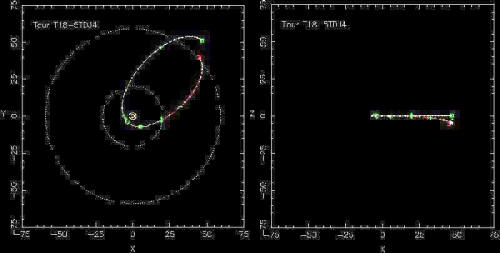
This restriction only applies, however, if Iapetus is not near one
of its two nodes -- two opposing points (see red line - below) along
its orbit, where it must cross the plane of all the other
satellites, twice every 79 days; if you time a spacecraft rendezvous
for there ... then there’s no “expensive” plane change involved at
all! And, the number of times you can visit Iapetus (within
Cassini’s current fuel margin) opens up enormously.

This, in fact, is how the December 31, 2004 “coincidental far
encounter” was accomplished; Iapetus was near the node on the left
(above), when Cassini (because of the forced change in the celestial
mechanics previously described for Titan) swung out to within 80,000
miles of Iapetus’ 2 million mile orbit -- on its way back in toward
Titan and the Huygen’s landing, January 14th.
Courtesy of
JPL’s “Solar System Simulator” (below), this will be the
view from Cassini as the spacecraft nears this one specially-planned
close-encounter with Iapetus – on September 10, 2007.

As can be seen, the timing is impeccable for imaging in
unprecedented detail (and at a perfect lighting angle) not only the
western end of “The Great Wall of Iapetus” … stretching across the
dark expanse of “the Ellipse” … but one end of The Wall’s apparent
“beginnings” – over the second “ring-basin” (below), two thirds of
the way around Iapetus. On the JPL simulation (above), one can even
see the line of “12-mile-high-mountains” ... which seem to mark the
western boundary of The Wall.
The 2007 Cassini fly-by should send us close-ups of these
extraordinary features that are literally 1000 times better than
this image (below) ….

Courtesy of Tilmann Denk (one of the
Cassini Imaging Team members),
these (below) are the currently planned, actual 2007 narrow angle
camera imaging sequences -- designed to gain additional insights
into “The Great Iapetus Wall” ….

But all this won’t occur for almost two more years ….
In the meantime, Cassini will be maneuvered into a variety of other
orbits around Saturn -- via those repeated “slingshot maneuvers”
utilizing the gravity field of Titan – all designed to bring it
breathtakingly close to several of the inner moons, the rings, and
to place it in position to examine extended regions of Saturn’s
far-flung magnetosphere (below).
And, of course, Cassini will relentlessly pursue its planned 44
close observations of Titan itself, on each repeated close approach
… on every “slingshot.”
During all this time, however, as we wait patiently for two more
years – particularly, as Cassini repeatedly approaches the dangerous
rings themselves – anything could happen to the spacecraft ... and
we could without warning lose a priceless opportunity to fully
explore and resolve the now immense scientific and cultural “SETI
opportunity” presented by the deepening mysteries of Iapetus ….
That must not be allowed to happen.

So, if we could sweepingly redefine the priorities of the Cassini
Mission (based on the startling information presented here, and its
non-trivial scientific and social implications …), what vital
information could we learn from even one or two more dedicated
fly-bys of Iapetus … and much sooner than two years?
Let’s start with the “moon’s” overall geometry.
The most obvious, most blatant evidence of artificiality for Iapetus
comes from its overall,
totally bizarre geometric form (below).
Even in a recent paper (2000), whose authors included some Cassini
team members, it was admitted:
… limb fitting of Voyager data shows that the shape of
Iapetus can
be described by an ellipsoid with half-axes 750 km X 715 km ….
However, note that Iapetus’ shape is irregular rather than
ellipsoidal … measured radii vary between 700 km and 780 km. An
irregularly shaped, Iapetus-sized body is something quite unusual in
the solar system [emphasis added] ….
As these measurements were conducted on “conventional” Voyager
images, and did not utilize the long-exposure “Saturn shine” Cassini
techniques described in Part 2, they are in fact serious
underestimates for how truly “unusual” and geometric Iapetus’ limb
turns out to be (though, they seem to have been one of the key
incentives for the long-exposure Cassini observations which
confirmed this extraordinary information …).
What’s needed now is an extended series of similar, over-exposed
“silhouette views” of the rest of the sunlit limb of Iapetus … all
the way around … taken from many different angles and points along
its orbit -- which can then be combined into a 3-D computer model to
derive the actual “non-spherical” geometry of this bizarre “moon.”

Fortunately, this does not require particularly close fly-bys to
accomplish, merely the targeting of multiple, distant narrow-angle
images of Iapetus with different exposure settings … as Cassini is
simultaneously pursuing other studies of the Saturn system ….
What does require a series of close encounters to truly be
effective, is a comprehensive surface survey of the composition of
Iapetus – particularly, the “dark ellipse.”
Here (below) is some of the early composition data NASA’s published,
acquired by Cassini’s Visual and Infrared Mapping Spectrometer
(VIMS) during the December 31 Iapetus encounter. As can be seen, the
results are very preliminary – mainly at this stage identifying the
“light stuff” around the brightly reflective north polar regions as
“water ice” ... and the “dark ellipse stuff” as being composed of “a
mixture of organics ….” But, “organic” what?!

Before Cassini, another paper -- addressing this same
several-hundred-year-old problem --
was published in 2001:
We present new [Earth based] spectra of the leading and trailing
hemispheres of Iapetus from 2.4 to 3.8 m. We have combined the
leading hemisphere spectra with previous observations by others to
construct a composite spectrum of the dark side (leading) hemisphere
from 0.3 to 3.8 m. We review attempts to deduce the composition of
the dark material from previously available [ground-based]
spectrophotometry. None of them (numbering more than 20 million!)
leads to a synthetic spectrum that matches the new data. An intimate
mixture of water ice, amorphous carbon, and a nitrogen-rich organic
compound (modeled here as Triton tholin) can fit the entire
composite dark side spectrum. Observations in this spectral region
have not revealed this mix of material on any other object observed
thus far [emphasis added] ….
This potentially key relationship of the Iapetus “dark stuff” to the
other significant anomalies we have presented will be discussed in
greater detail later.
To ultimately understand where these mysterious surface materials
have come from – whether the “dark stuff” is internal, and has (for
some reason) welled up from Iapetus only on one side, or if it is
external … and has rained down over time on the “front” of Iapetus
as it orbits Saturn (to say nothing of the question: “Which came
first? Is the dark stuff on top of the light stuff? ... or, is the
light stuff draped over the dark stuff ?”) – will ultimately be
determined only by the details of much higher-resolution VIMS
composition maps.
And that (if you look at the size of the ~ 40-mile pixels in the
VIMS multi-spectral image - above) will require getting a lot closer
….
In fact, it will require optical-scale resolution for VIMS, to
resolve details on Iapetus sufficient to determine regional
differences in the distribution and the composition of the “dark
stuff.” Which, in turn (for global coverage) – will require
repeated, close-up fly-bys … at differing distances, geometries and
lighting.
Which brings us to the critical, much higher-resolution new imagery
required now (from
Cassini’s Imaging Science Subsystem – ISS) of
this extraordinary “moon” ….
Now that we have identified several striking areas on Iapetus from
the previous imaging -- each exhibiting large-scale, unquestionably
geometric surface features, which, together, present a highly
provocative case for intelligent construction -- we obviously need
much higher resolution imagery to literally resolve what we are
seeing. Unfortunately, if you look again at the currently planned
Cassini close approach to Iapetus in September, 2007 (below), the
hemisphere which will receive the highest resolution imagery of the
current Cassini mission during that one planned fly-by … is NOT the
hemisphere that was imaged in December, 2004! It’s the other
hemisphere ….
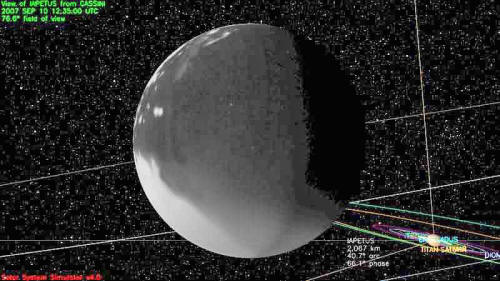
Thus, we will NOT have much (if any!) “overlapping, confirmatory,
high-resolution imagery” of the remarkable anomalies that we have
now identified on the lower-resolution pictures from December, 2004.
It’s somewhat difficult to test a hypothesis ... with a different
data set!
The remedy for this is very simple: schedule at least one more,
similarly close fly-by of Iapetus (in addition to September 10,
2007) ... when the lighting and viewing angles are similar to the
December 31st encounter.
By good fortune (for that pesky “plane change problem” …), this
additional encounter would also have to occur near the western node
of Iapetus’ orbit -- when the “moon” is cutting down through the
plane of the other inner moons, the rings … and Cassini’s current
trajectory around Saturn (below). If an additional fly-by were to be
planned for that brief window (we’ll describe “how” this can occur,
with your help, in Part 4), this additional reconnaissance (together
with the 2007 encounter data) would give us, at minimum, adequate
imagery of most of Iapetus’ surface … at a level of detail at least
100 times the current imaging.

Only this type of synoptic, comparative, high-resolution coverage
will allow truly scientific conclusions regarding the mind-boggling,
potential artificial nature of the amazing Iapetus’ geometry we’ve
found ….
But, the importance of ultra-close-up imaging notwithstanding, the
most important new observations Cassini could carry out at Iapetus –
but only during really close fly-bys -- would be a series of
side-looking radar observations … 3-D radar images of all that
amazing “stuff” that’s down there!
Cassini is equipped (the first time for any outer planets mission)
with instrumentation capable of active and passive radar
observations. Its
well-advertised mission priority is “radar
imaging” the surface of the perpetually haze-shrouded largest moon
of Saturn, Titan (in this false-color IR composite by Gerry Geist –
below). But, “if time permits” (according to the official NASA press
release …) other targets also can be examined – including some of
the icy moons … and the rings.

During the first close-up Cassini Titan fly-by, in October, 2004,
the spacecraft’s side-looking radar returned
a fascinating strip of
imagery -- about 150 miles wide by almost 300 miles long (below) –
showing the alien Titan landscape for the first time in a radar
view, this one taken from only 750 miles above its surface.
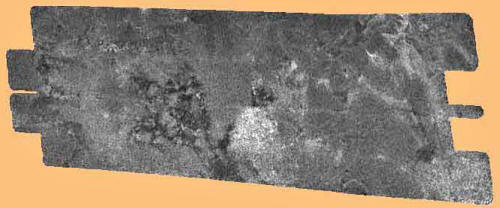
From JPL (below), here’s a brief
technical explanation regarding how
side-looking radar “sees” a planetary surface ... and what it can
detect:
… a useful rule-of-thumb in analyzing radar images is that the
higher or brighter the backscatter on the image, the rougher the
surface being imaged. Flat surfaces that reflect little or no
microwave energy back towards the radar will always appear dark in
radar images. Vegetation is usually moderately rough on the scale of
most radar wavelengths and appears as grey or light grey in a radar
image. Surfaces inclined towards the radar will have a stronger
backscatter than surfaces which slope away from the radar and will
tend to appear brighter in a radar image.
Some areas not illuminated by the radar, like the back slope of
mountains, are in shadow, and will appear dark. When city streets or
buildings are lined up in such a way that the incoming radar pulses
are able to bounce off the streets and then bounce again off the
buildings (called a double-bounce) and directly back towards the
radar they appear very bright (white) in radar images. Roads and
freeways are flat surfaces so appear dark. Buildings which do not
line up so that the radar pulses are reflected straight back will
appear light grey, like very rough surfaces [emphasis added] ….
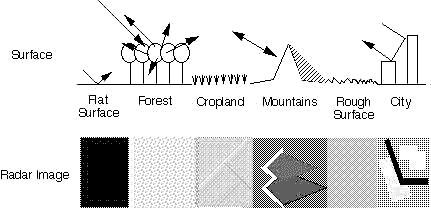
Imagine what this technique – which could easily confirm the
“impossible” geometric forms littering the surface of Iapetus, much
as it would see a terrestrial city filled with similar geometry
(above - right) – could see in a close fly-by of Iapetus. And, what
it could see inside Iapetus – if the short wavelength radar beams
(2.2 cm) penetrated several miles into the interior, though the many
apparent gaping “holes” (those pitch black features …) seen in the
visible light images?
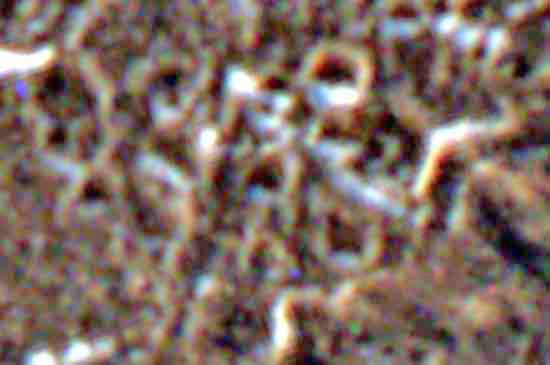
If used to electronically scan this unique Saturnian “moon,” the
on-board Cassini radar transmitter and receiver -- utilizing the
13-foot-wide high-gain communications antenna on the end of the
spacecraft (below) -- could create unbelievable high-resolution
radar “imaging strips” across some of the most striking, large-scale
geometric structures we’ve now discovered on Iapetus.

A prime target of such observations, now, would be the mysterious
“Great Wall.”
Imagine (depending on what it’s really made of …) being able to see
details inside this astonishing structure with the Cassini radar,
using this unique capability already at Saturn to gain crucial new
scientific insights into its potential artificiality … not possible
from any other scientific instrument on board (below).

It has only been in the last few years that Earth-bound radars –
like the upgraded
Arecibo Radio Telescope (below) – have been able
to send a 900 kilowatt signal all the way to Saturn (~770 million
miles from Earth) … and get an echo back from its (compared to
Saturn, or the rings) relatively tiny icy moons. In analyzing the
first radar echoes from Iapetus, in 2002, several new surprises were
discovered.

According to
Gregory Black, team leader from the University of
Virginia:
It is known that the bright [trailing] side is mostly water ice, but
we find it does not reflect the radar like other icy satellites that
we've studied with the radar before. The ice on Iapetus appears much
less reflective.
Another surprise is that the radar system sees
Iapetus as a uniform
object [red line - below], meaning no difference between the light
and dark sides [emphasis added]….

Black’s et al. 2004 Science paper also put forth a plausible
explanation for this anomalously low radar reflectivity of the
“bright” (icy) side of Iapetus:
… the addition of 10 to 30% by weight of ammonia to water ice can
increase its microwave absorption. Ammonia may have been an abundant
constituent. In the saturnian protonebula that would have been
incorporated into its satellites. The absence of spectral evidence
for ammonia and ammonia products on the surface may be the result of
selective depletion by ion sputtering, leaving an ammonia-poor crust
over an ammonia-rich ice that would affect the radar reflectivity
yet remain undetected at optical and infrared wavelengths ….
The authors extended this speculation re some kind of “Iapetus radar
absorber” to the equally puzzling lack of a significant difference
in the radar returns … between the leading and trailing hemispheres:
… a less likely absorber candidate is the dark material that covers
the leading hemisphere. Although it appears to have a minor presence
on the brighter, trailing hemisphere, an admixture of material in
the ice below the surface could still attenuate the radar signal. To
match the optical and infrared surface, this scenario would require
a mechanism to deposit clean ice over the dark material on the
trailing side [emphasis added] …
Given what we’ve discovered about Iapetus from the
new Cassini
images however, we are now in a unique position to suggest a very
different explanation for this remarkably low radar return ….
Beginning in the 1960’s, based on new radar and electromagnetic
interaction theories developed by
Russian physicist, Pyotr Ufimtsev,
including his classic “Physical Theory of Diffraction,” a way to
make aircraft far less vulnerable to World War II-developed radar
began to be explored. But, it is only in the last 20 or so years
that this formerly super secret “black” technology – popularized as
“stealth” – has finally come to light.
The full story behind the decades-long development (ironically, not
by the former Soviet Union but by the United States) of this highly
advanced military “countermeasures” radar technology is truly
fascinating – finally culminating in the public revelation (by the
U.S. Air Force, in the 1980’s) of a radical new fighter bomber
called the “F-117” (below).
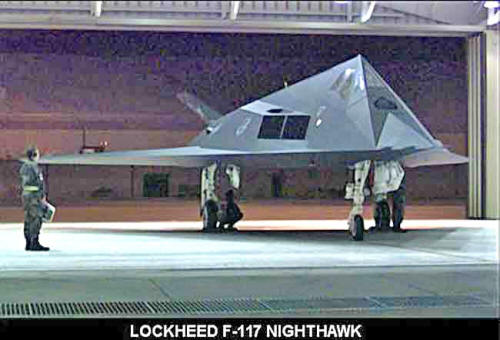
The technology beyond how “stealth” works – how an aircraft can be
made to almost disappear from modern radar – relies on two, in
principle, very simple properties: what the aircraft’s made of
(and/or, what it’s coated with) ... and what geometry it has
assumed.
Some materials (like the “ammonia/ice combination” discussed in the
preceding Science paper), absorb short wavelength radar signals
quite effectively. If an aircraft were coated with such a mixture,
it’s so-called “radar cross-section” could be significantly reduced.
In practicality, these radar-absorbing technological materials are
not composed of impossible, frozen ammonia mixtures (!), but of
special, internal “re-entrant triangle geometries” -- coated with a
unique compound called a “carbonyl iron ferrite” … one of several
metallic paints.
The result is a combination which effectively absorbs almost all
microwave energy … across a major portion of the electromagnetic
spectrum … resulting in true “stealth.”
The companion method of making such a “stealthy” aircraft involves
aerodynamically designing the airframe this “radar-absorbent
coating” will be applied to, in such a way that incoming radar beams
are NOT directly reflected back toward the radar’s source. This
involves incorporating highly unusual planar geometry in the
aerodynamic design … then applying the radar-absorbent coatings to
this geometric airframe.
The result is what gave the F-117 its unique, almost “alien” (and
threatening) appearance when it was finally publicly unveiled
(below): a plane that’s truly more like a collection of flying
pyramids … than a late 20th Century aircraft!
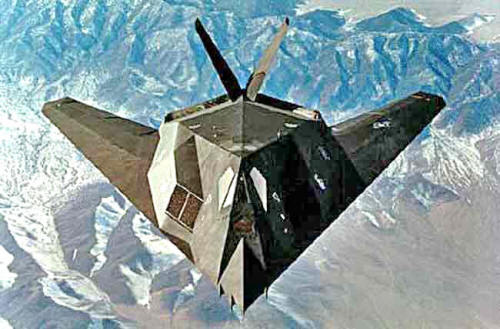
The reason for the pyramid-like appearance of the F-117 is directly
related to this fundamental principle of stealth technology: a
shape
that geometrically redirects -- by simple reflection -- incoming
radar energy away from returning to the transmitting antenna
(below)!

Applied to what we have just measured -- regarding Iapetus’
astonishing faceted geometry -- it seems equally likely that
another, remarkable reason for Iapetus’ “anomalously low radar
reflectivity” could now be seriously proposed—
That, like the F-117’s fundamental stealth design, the “moon’s”
Platonic geometry is redirecting incoming radar energy away from any
radar source (below)!
The implications of this are far reaching ….

A major optical confirmation that this is what’s occurring is
provided once again by the new Cassini imaging.
Here (below), we display two of the “Saturn shine” exposures of
Iapetus, acquired one day apart – on October 21st and 22nd, 2004.
Look carefully at those long “diffraction spikes” that emerge in
opposite directions in both images. Those are caused by the way the Cassini CCD camera system is oversaturated by a brilliant reflection
from apparently one small, sunlit region on the trailing side of the
“moon.”

Now, if you measure the distance of this bright reflection from the
sunlit limb, using the “diffraction spikes” as reference -- from one
image to the next you’ll see that it is changing … the reflection
getting significantly closer to the visible “moon’s” edge as the
orbital viewing angle between the spacecraft, Iapetus and the Sun
narrows over roughly a 24-hour period.
This progressive movement, relative to the “moon’s” edge as the
viewing angle changes, is the central hallmark of a mirror-like
reflection – a so-called “specular reflection” (from the Latin
specula, “mirror”) – but in this case, not by a normal spherical
surface (simulation, below – left) … but created by one of those
huge, flat Iapetus surface areas (simulation, below – right),
bouncing the scattered image of the Sun itself, from thousands of
square miles, directly into the Cassini camera … an enormous flash
of sunlight from one of the same flat areas seen profiled on the
limb (below – bottom) as “a hundred-mile-long straight edge!”

An identical “mirror-like phenomenon” – but coherently reflecting
radar signals away from any transmitters -- could in principle now
explain the curiously “stealthy” Arecibo echoes recorded from
Iapetus in 2002/2003. This startling new possibility – and its even
more startling implications – only strengthens the idea that Iapetus
could, in fact, be “an ancient spaceship moon ….”
It also heightens the stakes for why this entire, extraordinary
hypothesis must now be tested -- by going back to Iapetus as soon as
possible … this time, also utilizing the full capabilities of
Cassini’s on-board radar.
Bulletin!
During the December 31, 2004 fly-by, according to
a published
pre-encounter timeline just discovered, the on-board Cassini RADAR
experiment—
Should have already acquired such critical new data on
Iapetus!
But, remarkably – out of all the many experiments and observations
carried out by Cassini during its Iapetus encounter last December --
JPL has not published any results from these first, new radar
observations of Iapetus! The echoes were to be acquired in several
time windows, spaced throughout the two-day encounter -- from “about
14 hours before … to 20 hours after, Closest Approach” (see
timeline, below).

In terms of how these and other Cassini radar observations were to
be carried out, here is what
another official JPL release has
stated:
… At altitudes between 22,500 and 9,000 kilometers (about 14,000 to
5,600 miles), the radar will switch between scatterometry and
radiometry to obtain low-resolution global maps of … surface
roughness, backscatter intensity and thermal emissions. At altitudes
between 9,000 and 4,000 kilometers (about 5,600 to 2,500 miles), the
instrument will switch between altimetry and radiometry, collecting
surface altitude and thermal emission measurements. Below 4,000
kilometers (about 2,500 miles), the radar will switch between
imaging and radiometry ….
Since Cassini never came closer to Iapetus in this encounter than
about 80,000 miles, there could be no meaningful radar imaging
during this particular opportunity (Cassini was too far away to
receive adequate signal strength, and the geometry was wrong …).
But, according to this published pre-encounter timeline (above),
there was expected to be enough signal for simple “scatterometry”
scans (echoing efforts …) -- to compare Cassini’s recorded return
signals directly with the puzzling 2002/2003 much more distant
Arecibo’s radar returns ….
Yet, despite the simplicity of the experiment and the obvious high
scientific interest—
As previously noted, as of this writing there have been NO published
results – not even abstracts -- concerning last December’s Cassini
radar echoes of Iapetus!
In striking contrast, NASA has presented reams of
close-up images,
preliminary composition measurements and estimated surface
temperatures on Iapetus, a wide variety of data acquired by the
cameras and spectrometers during the same December 31 encounter –
much of it released within just days. It has even offered
“wall to
wall” raw imaging results on its Cassini website -- from not only
all the Iapetus encounters so far, but of the fly-bys of ALL the
other moons since it arrived at Saturn on June 30th.
During the first Cassini satellite encounter – the ~1200 mile
historic fly-by of the 136-mile diameter, retrograde Saturnian moon,
Phoebe – the Cassini RADAR experiment “pinged” a variety of signals
off tiny Phoebe, as the spacecraft flew by on June 11, 2004, during
its final few-million-mile approach to Saturn, after its seven year
journey out from Earth ….
Official acknowledgement of preliminary results from these historic
Phoebe radar scans
was made almost immediately … on June 18th …
within a week of the encounter. And
a more detailed scientific paper
on the Phoebe radar data was presented to the American Astronomical
Society’s annual Division of Planetary Sciences Meeting, in
November, 2004. In that paper, anticipation of the up-coming
December Iapetus radar observations was specifically cited (as a
means of further, crucial calibration of the entire Cassini RADAR
system) ….
But, after these “key observations” in December
were successfully
carried out, on the small matter of how Iapetus – a much more
important target than Phoebe, one with far-reaching implications for
the origin of the entire Saturn system (and, remember, key to
“successful calibration of the entire Cassini radar system …”) --
actually reacted to these first-time Cassini radar scans ….
Nothing.
This, despite the fact that Dr. Charles Elachi, Principal
Investigator for the Cassini RADAR Experiment, also happens to be—
The Director of JPL itself!
In fact, it gets stranger.
Unlike the DPS meeting following the Cassini Phoebe encounter, at
which Elachi’s team couldn’t wait to report its first results, the
JPL RADAR team seems almost to be hiding … following the first radar
close-up of Iapetus ….
In the next few weeks (March 14-18, 2005), a world-class, annual
scientific meeting will once again take place in Houston, Texas --
the 36th annual
Lunar and Planetary Science Conference (below). This
is the yearly get together where all the latest NASA and other
global space agency solar system discoveries are presented from the
preceding year. This year, three historic planetary missions and
their results are taking center stage:
-
the amazing NASA Mars Rovers
... because of their historic year-long surface explorations of the
Red Planet
-
the European Space Agency’s equally important Mars
Express orbital Mars Mission …
-
NASA’s Cassini
Saturn Mission ….

A survey of the accepted scientific papers, already listed in
the
official program on the LPSC 2005 website, reveals the usual wide
spectrum of solar system physics and discoveries to be presented at
this year’s Conference – including, three Special Sessions devoted
exclusively to the latest Cassini Saturn results. In fact, there are
seven papers in the Third Session alone, totally devoted to the
first Cassini RADAR observations of Titan (below).

But—
Out of a total of 39 Cassini papers at this Conference (not counting
poster sessions …) -- NOT ONE is going to address the first Cassini
Iapetus radar results!
Not one ….
And that yawning, official silence -- given the literally hundreds
of years that this Saturnian moon has puzzled generations of
Earthbound astronomers, and after the first application of a radical
new technology which might finally solve those centuries-old puzzles
-- is just very, very strange ….
So -- what did Cassini actually hear on December 31 … that would
make JPL and NASA now treat the first, highly anticipated Cassini
RADAR observations of Iapetus as if they never even happened?
During
the 2002 and 2003 Arecibo radar efforts, Black’s et al.
observations of the trailing side only spanned three days – from
January 8th to January 10th; their 2003 radar data on the
mysteriously dark, leading hemisphere only two …. This meant that,
because of its long, 79-day orbit around Saturn, Iapetus only
rotated synchronously on its axis – relative to the incoming Arecibo
radar signal – by a maximum of just under ~14 degrees during the
2002 observations. And only about 9 degrees during the observations
in 2003 ….
Given a minimum of 14 straight-edged facets completely around
Iapetus from the October Cassini imaging data (count the outer edges
- below), this implies about a 26-degree angle between each facet.
Thus, the odds are that during the Arecibo observations in
2002/2003, the radar reflections – even over a three-day rotation of
the moon -- were not directed “normal” (90 degrees) to any
individual facet’s surface. This, as we noted earlier, would
elegantly explain why the signal seemed to be so “anomalously” weak:
most of the signal [apart from that reflected (“scattered”) by
random craters on this ancient, battered surface …] was actually
being geometrically, “stealthily,” reflected away from Arecibo …
into deep space.

But, what about the recent, much closer (less than ~ 200,000-mile)
Iapetus’ radar echoes from Cassini?
Let’s begin (again, courtesy of
JPL’s Solar System Simulator) by
looking at the polar geometry of that encounter.
Here (below) is a simulated view, seen from above the north pole of
Saturn (as well as the orbits of all the regular Saturnian moons,
including Iapetus -- the outer, grey semi-circle). Cassini’s
trajectory around Saturn since it arrived in mid-2004, ending
January 1, 2005, is marked in green. (On this scale, the Sun and
Earth are about 150 feet beyond the image, top).

As you can now see in this closer view (below), the spacecraft
started out “ahead” of Iapetus the night of December 31 (the “moon”
moving along its own orbit, counterclockwise, upward), as the first
Cassini radar sequence in the timeline was to begin: 04:29 UTC. This
meant, of course, that the first Cassini radar ever from the
mysterious object called “Iapetus” …

This first Cassini “scatterometry” radar sequence was supposed to
last 3.5 hours.
In that time, as you can see in these two new close-up Simulator
views (below), Iapetus was overtaking Cassini as they both orbited
Saturn, the two bodies almost approaching each other, head on.
So,
the transmission angle between the spacecraft and the mysterious,
dark hemisphere of Iapetus – but, in fact, the one with the amazing
“Wall” -- changed very little during these first planned radar
echoes -- only by about 2 degrees in that entire three and one half
hours – far less than the 2002/2003 Arecibo radar observations.

The second Cassini opportunity for dedicated radar observations of
Iapetus (again, according to the published timeline cited earlier),
was to occur on January 1, 2005 – some ~20 hours after spacecraft
Closest Approach – at 15:00 UTC (below). This scatterometry sequence
was to be of the far brighter (visually) trailing hemisphere, and to
last much longer than the first … ending at 23:45 UTC – for a total
second radar observation period of almost 9 consecutive hours.
In that time (below), the changing spacecraft angle with respect to
Iapetus’ far brighter hemisphere (visually), the one with the now
known “facets” (!), was considerably larger – some 15 degrees –
comparable with the earlier Arecibo observations. At the same time,
Iapetus’ own sidereal rotation (relative to the stars) amounted to
about one additional degree of angle change ….
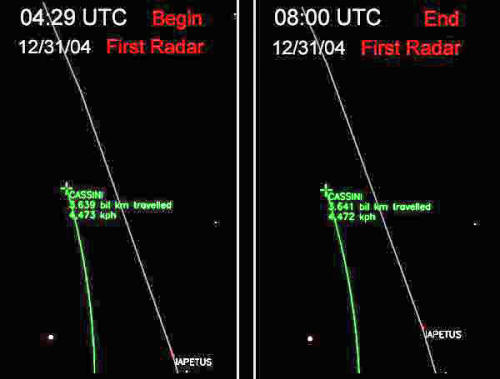
So, what am I getting at?
Because of its MUCH closer encounter distance (thus, significantly
greater signal strength and much lower noise than Arecibo …),
coupled with a long period of continuous radar observations, and the
relatively large angle-change during this second radar acquisition,
it’s possible (in fact, more than likely …) that Cassini observed a
dramatic, sudden INCREASE in received signal strength … as this
first radar program on Iapetus was being automatically executed by
the spacecraft.
This would have occurred as one of Iapetus’ “flat panels” -- because
of the “moon’s” rotation, coupled with the spacecraft’s motion --
approached ~ 90 degrees … relative to the receding NASA spacecraft
radar.
If that happened, Iapetus’ surface would have suddenly “lit up” with
an enormous burst of energy from Cassini’s outgoing radar signal --
reflected directly back toward the receding spacecraft, making it
appear as if the moon’s “cross section” had suddenly expanded by a
hundred (or more) times!
This “faceted return” (simulation – below) would certainly not have
been consistent with ANY natural planetary radar explanation ….

Given that the folks at JPL are fully as capable as we are of
putting this together, is it possible that this Cassini close-in
Iapetus radar return was SO anomalous, that it was correctly
analyzed … for what it was … within the first few hours of being
received at JPL:
the radar detection of an entire, artificial moon
-- explicitly designed according to
Professor Ufimtsev’s
cutting-edge electromagnetic theories?!
And that soon, “someone” – much higher up in government than
JPL (or
even NASA) – after seeing this definitive, highly anomalous radar
data … on a place with “hundred-mile-long-edges!” quietly issued a
“gag order” on this entire “Iapetus intelligence experiment” … in
consonance with “Brookings?!
Because they too were beginning to suspect that this--
Is now much more than “mere coincidence?”
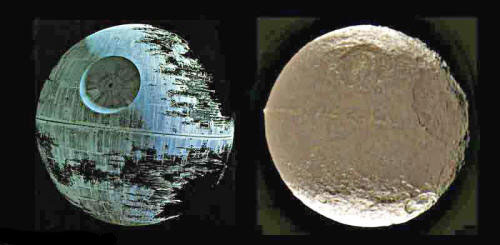
Click Here for Part Four
→
|







































